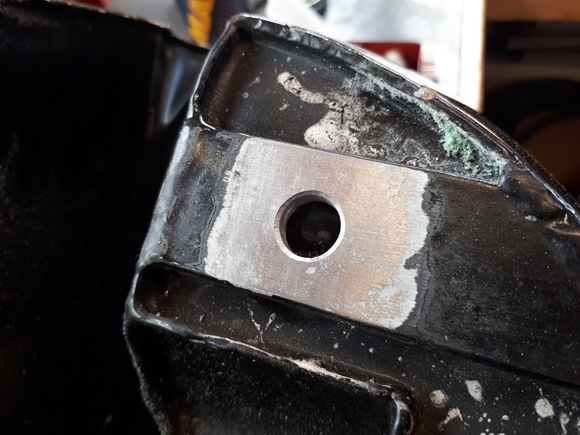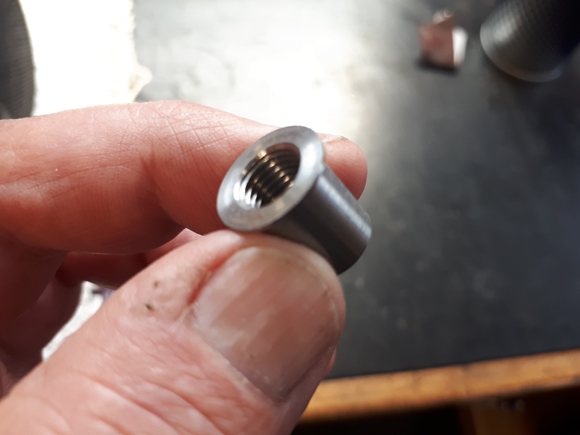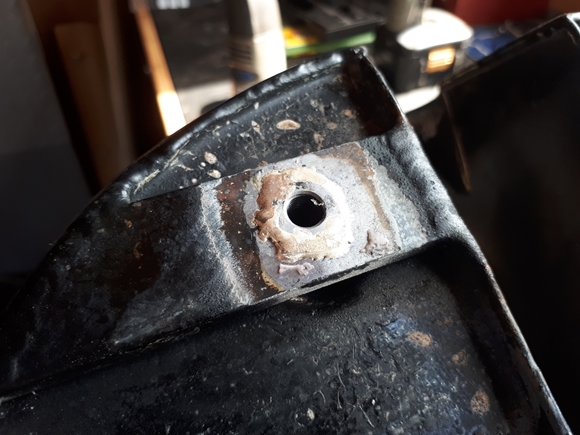Bess has been "run-in" and is performing admirably. With a garage full of other bikes to ride, I've not been able to ride Bess as much as she deserves. I did, however, run her down to the Strathmore Arms a couple of days ago. There and back at a steady 65-70 mph. Way to go!!
Wednesday, 24th May, 2023.
When I got back from the Strathmore Arms, I noticed that one of the petrol tank bolts had fallen out. It was still attached to the wire I'd used to stop it undoing. It turned out that the thread had stripped... as had two others, and the forth wasn't looking that good, either. It was not a very good fixing when it was new, over 70 years ago. The bolts are screwed into a tapped hole in a plate that is only 1/8" thick. It was time for a permanent solution. I drilled out the threaded holes to 7/16", and turned up four steel inserts to fit into the holes. These were drilled and tapped with the 5/16" BSCy thread to match the new bolts I'd ordered. The inserts were silver soldered into the original mounting plates. They had a full 1/2" of thread depth so there would be less chance of them being stripped again. OK... the silver soldering isn't that pretty, but I guarantee that the inserts won't drop out any day soon, and it didn't look that bad with a coat of black paint.




Thursday, 17th July, 2025.
 OK... lets move on 2 years. We're now half way through July and Bess is in the workshop again. To be truthful, I've not put many miles on her in the last couple of years but I have noticed an ever increasing amount of oil in the drip tray under the engine. The workbench was empty so Bess was brought in for a little investigative work. As it happens, it was pretty obvious that oil was gradually draining from the oil tank into the crankcase, commonly known as "wet sumping". It was also obvious that the crankcase was no longer oil tight as oil was dripping from the joint between the two crankcase halves.
OK... lets move on 2 years. We're now half way through July and Bess is in the workshop again. To be truthful, I've not put many miles on her in the last couple of years but I have noticed an ever increasing amount of oil in the drip tray under the engine. The workbench was empty so Bess was brought in for a little investigative work. As it happens, it was pretty obvious that oil was gradually draining from the oil tank into the crankcase, commonly known as "wet sumping". It was also obvious that the crankcase was no longer oil tight as oil was dripping from the joint between the two crankcase halves.
So... I've taken the decision to lift the engine out of the frame and split the crankcase. I've had the engine out twice before but I've never completely stripped the crankcase down to it's component parts. That's what will happen now, as I need to clean and seal the joint between the two halves.
Today I made a start and the only problem I encountered was removing the crankshaft timing pinion. It needed considerable heat from the oxy/MAPP gas torch and a special home made removing tool to get the timing pinion off the crankshaft.
Friday, 18th July, 2025.
 When I repaired the threads in the petrol tank a while ago, I had the tank upside down on the bench. I'd laid out a cloth to protect the paint but a lump of steel swarf went un-noticed and I ended up with some deep scratches in the paint. As the tank is currently off the bike, I took the opportunity to drop it round to Kris at the Lutton Body Shop. He's going to work some of his wizadry on it, and I expect that it will come back in due course looking perfect.
When I repaired the threads in the petrol tank a while ago, I had the tank upside down on the bench. I'd laid out a cloth to protect the paint but a lump of steel swarf went un-noticed and I ended up with some deep scratches in the paint. As the tank is currently off the bike, I took the opportunity to drop it round to Kris at the Lutton Body Shop. He's going to work some of his wizadry on it, and I expect that it will come back in due course looking perfect.
The engine is out and has been dismantled. The bottom end looks to be in very good condition. The main bearings are good, as is the big end. I'll start cleaning and reassembling next week. The crankcase split easily. It had been joined with what looks like red Hermatite but it was obviously not doing it's job any longer. I'll probably put it together with ThreeBond.
Wednesday, 23rd July, 2025.
I have mentioned in the past my "displeasure" with one (or possibly all) of the previous owners. What I found today pretty much eclipses all the previous bodges that I've encountered on this poor bike. Today, I started with washing the two crankcase halves in the parts washer. It was while I was drying the timing side half that I noticed that one of the two dowels that secure the main bearing bush and stop it rotating was missing. It was there when I started so it must have come out in the parts washer. A quick grope about on the bottom and I'd found it... or rather, I hadn't. I'd found what had been used but it wasn't a dowel; it was what looked like the bottom end of a nail that the PO had cut off and stuck in. I didn't know whether to laugh or cry!! Needless to say, that was disposed of in an approved manner and a new steel dowel was turned up on the lathe and pressed into place.
secure the main bearing bush and stop it rotating was missing. It was there when I started so it must have come out in the parts washer. A quick grope about on the bottom and I'd found it... or rather, I hadn't. I'd found what had been used but it wasn't a dowel; it was what looked like the bottom end of a nail that the PO had cut off and stuck in. I didn't know whether to laugh or cry!! Needless to say, that was disposed of in an approved manner and a new steel dowel was turned up on the lathe and pressed into place.
When I checked the two ball bearings in the drive side crankcase half, they didn't feel as good as I'd thought earlier. The bearings were removed in the usual way. The spacing washer that is fitted between them also showed a lot of wear on both sides. I'm not messing about this time, two new ball bearings and a new spacer have been ordered from Seven Surby at AMC Classic Spares. I also needed some new tab washers, for the little chaincase fixing screws and the clutch hub nut, so they were added to the order as well.
Saturday, 26th July, 2025.
It was while I was taking the engine out that I noticed that the three little hex head screws that secure the inner chaincase to the crankcase were loose. They were held by the tab washers but needed looking at. Well, I looked at them, and the threads in the crankcase were badly worn. They are an old British thread, "0 B.A.". I didn't have a repair kit for that thread size, but fortunately, Chronos did, and at a reasonable price, so I ordered one. That arrived this morning and the threads in the crankcase now have stainless steel heli-coil type inserts. I'm happier with that!!
Sunday, 27th July, 2025.
Time to fit the new main bearings. If you read the manuals, then conventional wisdom says that you hammer the bearings into the drive side crankcase half and then hammer the crankshaft through the bearings. OK... maybe not quite those words but they definitely say "drive the bearings into the crankcase using a suitable drift". That also poses the problem of lining up the spacing washer between the bearings as there is no positive location for it. If it's not positioned exactly, you won't get the crankshaft axle through the bearings when the time comes. There is also the possibility of damaging the crankcase as the bearing is driven in. I'm of the opinion that a hammer should only be used for banging in nails so I've come up with an alternative method. I used it successfully when I assembled the G3/LS engine.


 The crankshaft was left in the bottom draw of my freezer overnight. This morning, the bearings were warmed in the oven at 120°C for half an hour. With the crankshaft in position on the Workmate, the larger of the two hot ball bearings was dropped onto the drive side axle with a satisfying "ting" as it located against the shoulder on the axle. That was followed by the spacing washer and the smaller of the two bearings. As the bearings cooled down, the crankcase half was heated up to 175°C. That was subsequently lined up over the bearings and it dropped easily into position. That's it... bearings and crankshaft installed. No need for hammers and "suitable drifts" and no damage to any of the parts.
The crankshaft was left in the bottom draw of my freezer overnight. This morning, the bearings were warmed in the oven at 120°C for half an hour. With the crankshaft in position on the Workmate, the larger of the two hot ball bearings was dropped onto the drive side axle with a satisfying "ting" as it located against the shoulder on the axle. That was followed by the spacing washer and the smaller of the two bearings. As the bearings cooled down, the crankcase half was heated up to 175°C. That was subsequently lined up over the bearings and it dropped easily into position. That's it... bearings and crankshaft installed. No need for hammers and "suitable drifts" and no damage to any of the parts.
The trouble with the AMC frame is that it's bolted together from a lot of different parts. When you remove the 3/8" diameter stud from the bottom of the engine, the two frame side rails and the front down tube spring apart with a "boing" and you just know that you're going to have a problem getting that stud back through all the component parts when you try to put the engine back. This time, I'm going to try and preempt the problem with the use of three ratchet straps. By adjusting the tensions, I've pulled the three bits into a position where I hope I can get the stud through with the minimum of stress. Well, that's the plan, anyway!!
Friday, 1st August, 2025.
Well, that went better than I expected!! I sealed the two crankcase halves with a thin coat of "ThreeBond" and bolted them together a couple of days ago. I left them so that the sealant could "cure", if that's the right word, before the bolts were removed and the engine bottom end offered up to the frame and engine plates this morning. The troublesome bottom stud turned out to be no trouble at all and went through the frame and engine easily... Result!!. The magneto, dynamo, primary drive and clutch have all be assembled to the engine/gearbox.
Saturday, 2nd August, 2025.
A bit more done today... Oil lines attached with a new felt filter in the tank and a cleaned mesh filter in the feed line. The piston was fitted followed by the cylinder barrel. The crankshaft timing pinion was next, followed by the two camshafts. At this point, I had a choice... I could set the inlet cam to either of the two timing marks. There was one for the 350 and one for the 500. Although the cam profile is the same for both, the 350 inlet cam timing is advanced by one tooth, that's 9° of camshaft rotation as there are 40 teeth on the camshaft pinion, but 18° of crankshaft rotation, compared to the 500. This gives a little more performance and that was the one I chose to use. I spoke to Ken DeGroome a few years ago and asked him why the difference? He said that the 500 inlet cam timing was retarded slightly to make the engine more tractable and the bigger bike more suitable for hauling a sidecar.



After a break for lunch, the magneto contact points were cleaned and gapped. Then the ignition timing was set. That was achieved in the usual way with a dial test indicator on the piston crown to set TDC on the timing disc on the crankshaft. The timing was set to 39° BTDC using the box of electronic wizardry I bought from The Magneto Guys. That makes setting the timing accurately a piece of cake... No need for cigarette papers any more.
I suppose I should point out that these three photos are not from the current job... Top left is actually the M18S but was taken some years ago, before I moved to rural Lincolnshire. The two on the right are actually my G3/LS but they are the only photos I can find that show the DTI, timing disc and static timing light.
Tuesday, 5th August, 2025.
I wondered about the cylinder head. In the end I decided not to dismantle all the valve gear. There wasn't a lot of carbon and in the great scheme of things, she hadn't done many miles since the last rebuild. I did clean up around the spigot for the cylinder barrel. I used four Viton "O" rings on each pushrod tube instead of the solid rubber tube that's supplied in the gasket set. I've found that they give a more reliable seal for longer. The bolts were torqued down to 38 lbs/ft. The new copper gasket was annealed before use.
If you've come to this part of Bess's saga from parts 1 & 2, you may (but probably not) remember that she was a bit noisy mechanically, and at the time, I put that down to a very worn bore and piston. Well... I've found something else that may be a contributing factor... The rocker box, or more specifically the exhaust rocker spindle. There was about 60 thou end float. The end float on the inlet rocker spindle was barely discernable, almost zero. Don't know how I missed that last time... my bad! Anyway, I removed the nut and pushrod rocker arm, took a few measurements and turned up a bronze spacing washer. That was positioned over the spindle, behind the rocker arm, and the whole lot tightened up again. Perfect... everything moved freely with just the slightest amount of float. The rocker box was re-assembled to the head and the pushrods adjusted as per the manual... free to rotate but no up-and-down movement with the piston at TDC on the compression stroke.
Friday, 8th August, 2025.
The last few odds and ends were buttoned up today. Exhaust pipe, footrests, gearbox levers and rear brake rod. Only the battery, tank and seat to put back but they will have to wait until the tank comes back from Kris at the Lutton Body Shop.
Link to Index and Home Page.
Link to AJS M18S - Part 1.
Link to AJS M18S - Part 2.
Link to Matchless G3/LS page.
Link to Triumph Tiger 90 page.
Link to Triumph Bonneville T120R page.
Link to Matchless G80CS page.
Link to Honda VFR750 page.
Link to Norton 650SS page.
Last updated 08/08/2025